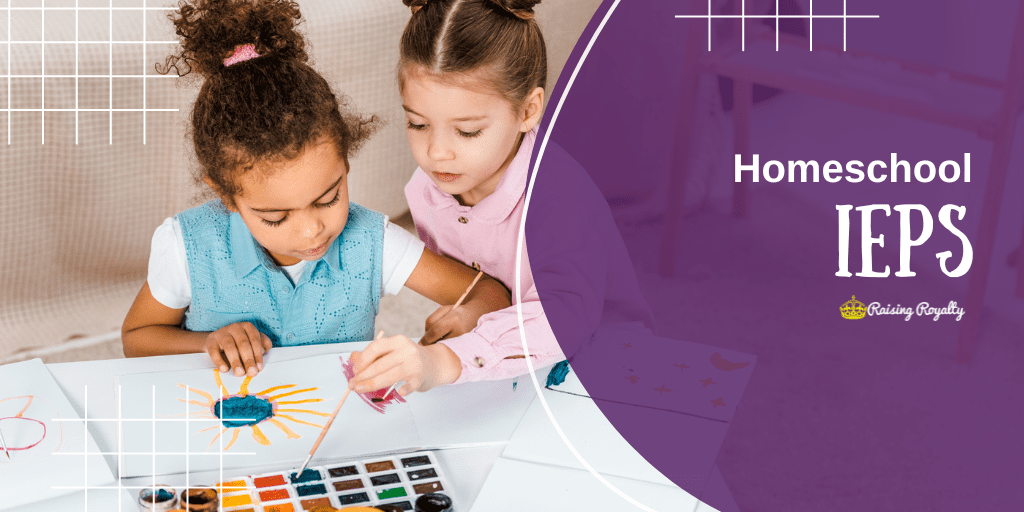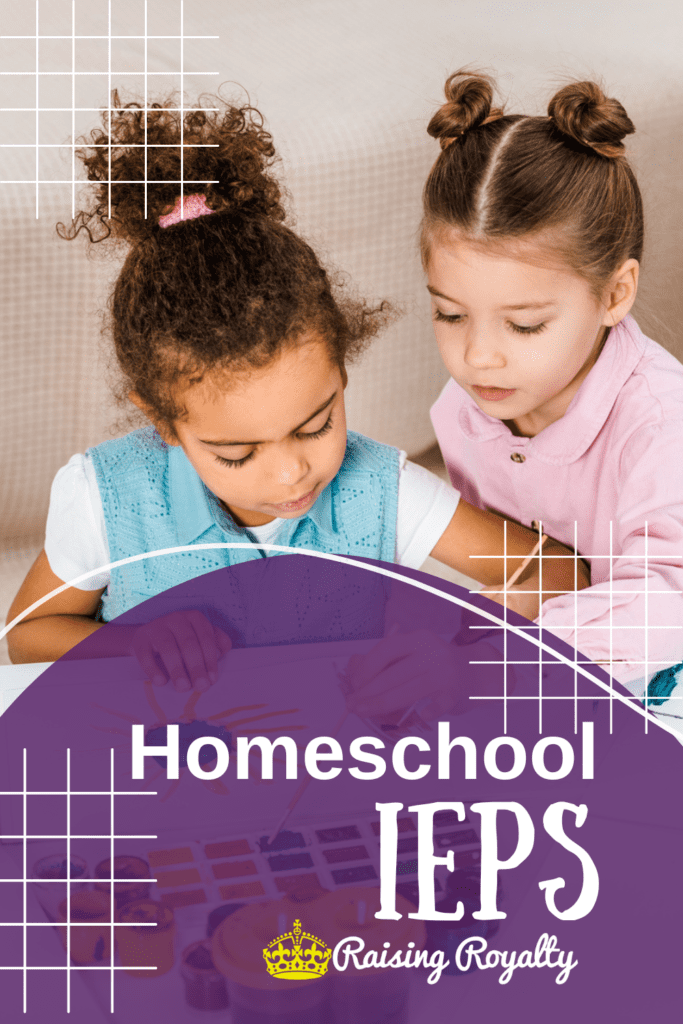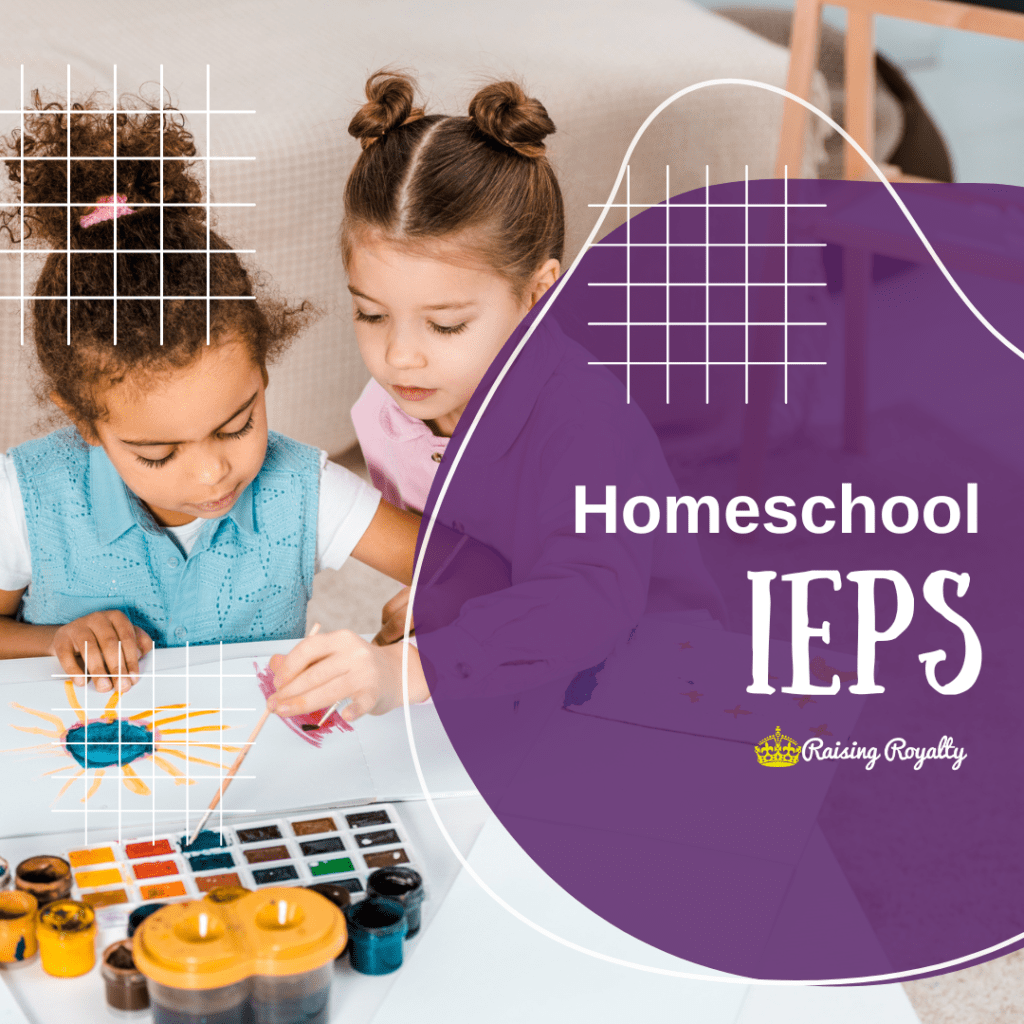
When you have a special needs school-aged child, school paperwork often involves IEPs. There’s meetings, forms, paperwork and assessments. It’s a lot of work and it can be intimidating, but when they work, IEPs help make sure that all the school staff know exactly how and when to help your child succeed in school. So when parents consider homeschooling their special needs child, one of the first things they wonder about is, do we need a homeschool IEP? And if so, how do we get that?
What is an IEP anyway?
An IEP is an “individualized education plan”. In many places, this is actually a legal document that schools, teachers, principals, school social workers & therapists, school nurses and other school staff, MUST abide by. It dictates just what can and can’t happen when dealing with the student that is the subject of the IEP.
When you homeschool, in essence, you’re creating an “individualized education plan” by virtue of the fact that your student is getting a tailor-made, customized education, whether they have special needs or not. So why in the world would homeschooling parents want to even think about creating a homeschool IEP for their special needs student?
Do you need one?
IEPs are essential for school, because they help everyone who is responsible for the student know what to expect and what to do. IEPs keep everyone on the same page, so there’s no mixed or missed messages — and they can help prevent or fix instances where the student experiences unfair treatment or unrealistic expectations.
At home, though, IEPs don’t really help with that. Since parents are the ones who are responsible for the child’s education, they can co-ordinate with therapists, doctors, and other specialists without an IEP.
But IEPs can still be useful, even if they aren’t essential for homeschoolers.
IEPs do more than just co-ordinate care and support — they take a “snapshot” of where a student is in their learning journey, and map out the next steps in detail.
And if you’re a homeschooling parent with a special needs child, sometimes you can get lost in the mountain of paperwork, and forget about the child.
IEPs help us focus on our kids and what THEY need most.
Here’s how to create your own Homeschool IEP.
Section One: Who is the student?
In school, this section would have all the identifying information about the child: name, address, student number, etc. It would also include a list of achievements, milestones and skills — their “strengths”.
For homeschoolers, this is a good place to put information about their physical characteristics (height/weight), and current likes, dislikes, interests and skills. Do they like stories? prefer video games? What about sports or games? Do they like animals or music or puzzles? Have they recently learned how to sew or cook eggs or type? How do they learn? What motivates them?
Create a word-picture of your child and who they are right now. Maybe even include a recent photograph.
Section Two: What is the diagnosis/disability?
In a school IEP, this is where you would list the labels & symptoms. You might include current doctors/specialists/therapists here as well. And then the areas of development or learning affected by the diagnosis are noted. Ie. An autistic child’s IEP might note that they struggle with communication of bodily functions due to a speech delay.
For homeschoolers, this is a good place to detail not just what the diagnosis is, but what areas of life that diagnosis might affect. While we don’t like to focus on our child’s struggles, it’s sometimes good to evaluate what their weaknesses are realistically, so that we can create a plan to help support those areas.
What that looks like in practice?
For example, if your child has a visual disorder, reading & writing might be harder than typical. If they have sensory issues, focus & organization might be more difficult. Struggle with auditory processing? Listening and following directions might be tougher.
Write down the areas where your child is struggling, specifically because of their disability. Don’t include struggles because they happen to be 7 years old, and wiggly. All 7 year olds are wiggly. But if your 7 year old is struggling to add & subtract because they have dyslexia, and the numbers keep switching on the page for them, then that’s an area to note on your IEP.
Section Three: Current Grade Level and/or Developmental Ability
In a school IEP, we’d put what grade they’re supposed to be in (by birth year) and what grade level their work has achieved. So for my 13 year old, by birth year she should be grade 8. But her work level in math, for example, is beginning grade 3. Her reading comprehension is around a mid-to-late grade 4 level. Most IEPs would include copies of any recent assessments and tests here.
In your homeschool IEP, this is a good place to also include any formal or informal assessments you may have done. If you’ve done a reading placement or skills diagnostic test, put a copy here.
Then, think about where your child is right now, developmentally. What milestones have they achieved? What are they competent at? And what are they capable of?
Write down what makes sense to you at a glance, for future reference.
Section Four: Current Treatments & Interventions
For school IEPs, all the therapies, current school supports, and intervention “in case of” plans would be kept here. They would put what they currently do or would do to help your child in case of emergency. For example, if your child had a life-threatening allergy, this would be where the plans about where things like epi-pens are kept, who gets to administer, and what the next steps are, should there be the unfortunate case of an allergic reaction.
For your homeschool IEP, this is a good place to list out what you’re currently doing right now to help and support your child. If your child is in therapy — like speech & language therapy, or OT — list the therapist, their contact info, any copies of their latest reports, and times and length of time of therapy sessions.
You can also list out the informal things you’re doing to help your child.
For example, when my ADHD child was still homeschooling, I would list out the use of fidgets, checklists, colored pens & timers as tools I use to homeschool her and help her learn. Maybe you have a weighted blanket, or a playlist for school? Maybe it’s a certain kind of snack only eaten after finishing math or a special activity only done when your child needs a break from school to help them self-regulate.
Next to each intervention or therapy or tool, write what you used it for and assess how well it’s working. Is it something you want to continue? Or is it something you’ve tried and it’s not working at all. Or maybe it worked in the past but now it’s no longer needed? Keeping a record of what you’ve tried will help prevent you from wasting your time on things that don’t work, and give you tools to try when you deal with similar issues in the future.
Section Five: Goals & Next Steps
IEPS in schools will list out the next appropriate milestone, developmental skill or academic level for your child in this section. Then they’ll create plans on what interventions, therapies, tools or supports are needed to achieve those goals. And finally, they’ll put down what the end result should be when the child succeeds. They’ll also date these, because IEPs are for a specific amount of time, and are re-evaluated regularly.
It’ll read something like this:
“[Name] will use [tool] to [do task related to goal] per method taught in [therapy]”
or this:
“[Name] will demonstrate [learned skill] based on [therapy sessions] at [assessment period]”
There’s usually a lot of detail included in this section.
Bigger goals are broken down into specific skills and tasks, and then the desired outcome. The tools and therapies used to teach or develop these specific skills accompany each one. And then the specific tool or method used to assess each skill is listed as well.
So for your homeschool IEP, get specific. What areas of development or new skill will you work on next with your child? What level or skill do you (or they) want to learn?
Maybe your child wants to write more stories. But their area of struggle is with fine motor skills, so holding a pencil to write with is not only frustrating but exhausting. Instead, you’re going to teach your child how to use a speech-to-text writer so they can focus on developing their storytelling skills rather than getting stuck with the physical act of writing. So your IEP will read:
“[Name] will write a 1 page short story, with 3 characters, a climax, and a happy ending, using speech-to-text writing tool.”
Section Six: New Interventions And/Or Therapy
As children grow and develop, they transition into new skills and new environments. So school IEPs will often include transition goals and list out any new or recommended interventions and therapies. This might include who will refer and to where, any assessments that need to be done and when, and when the next IEP meeting will be.
So for your homeschool IEP, you might consider doing similar. Include any new therapies, alternative-to-therapy programs, referrals, referrals-wanted (and who you’ll get to do the referring), and any assessments you need or want.
But you don’t have to stay with formal therapies and assessments. Maybe you’ll include a book you want to read about your child’s needs, or a new tool or technique you’ve recently learned about that might help your child achieve a goal. Think about what you can do to support your child’s development and learning of new skills. And don’t forget to include how you’ll know what you’re doing is working.
How to Use your IEP
Once you’ve put together your homeschool IEP, what do you do with it? Sure it’s an interesting exercise, but is it really useful?
IEPs in school help guide teachers and support staff on what to teach, when to teach it and how to teach it. They also help make sure that teachers don’t get frustrated trying to teach skills or concepts that your child may not be ready for — or may have already mastered.
Homeschool IEPs are foundational planning documents.
For the homeschooling parent, IEPs can help guide everything from curriculum choices to schedules and lesson planning.
They’ll help you save money, because when you know where your child is at academically, you’re not going to buy curriculum that doesn’t fit them. Like I’m not going to be tempted by a 5th grade math curriculum, when I know my daughter hasn’t mastered 4th grade math yet.
And since you’ll have a snapshot of where your child is developmentally right now, it means that you’ll be able to see the progress much more realistically. That’s incredibly encouraging! It’s a lot easier to celebrate your child’s achievements when you can see how much they’ve learned.
And that makes the IEP worth its time and effort.



